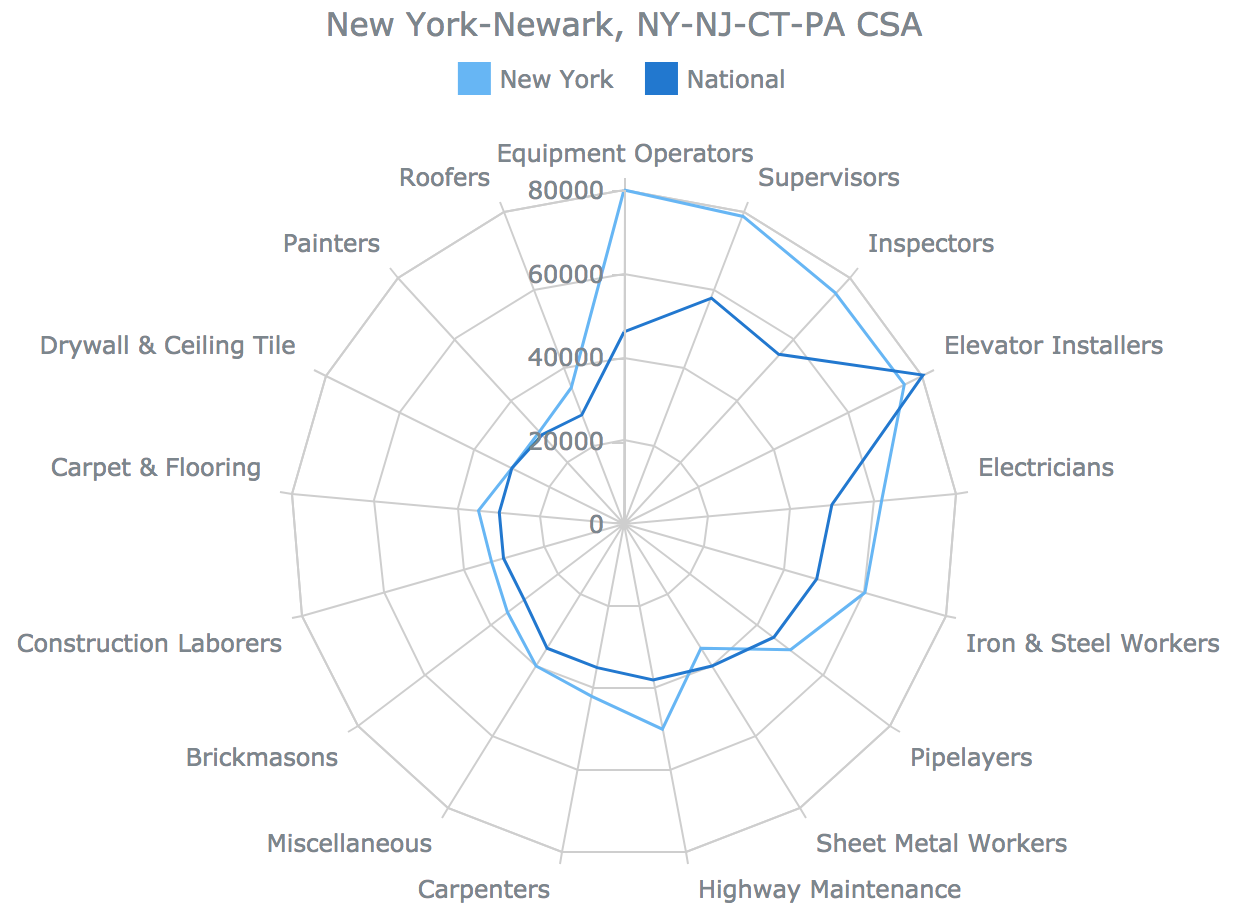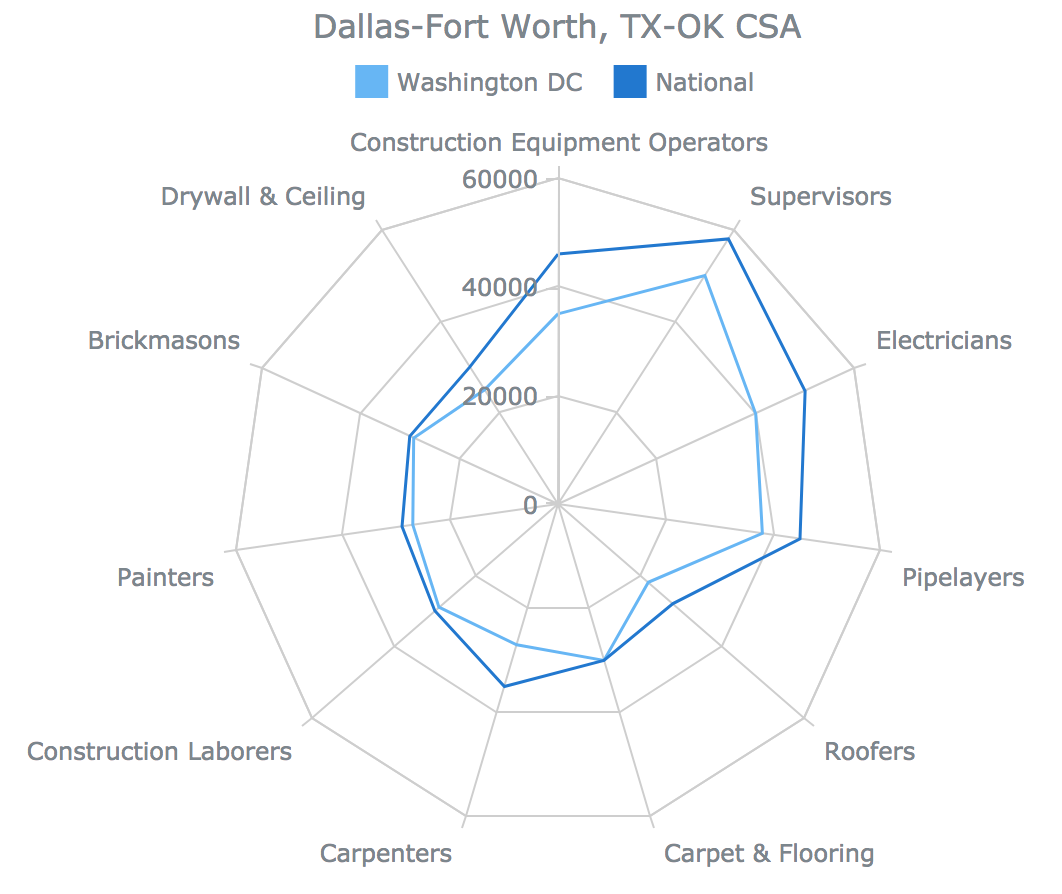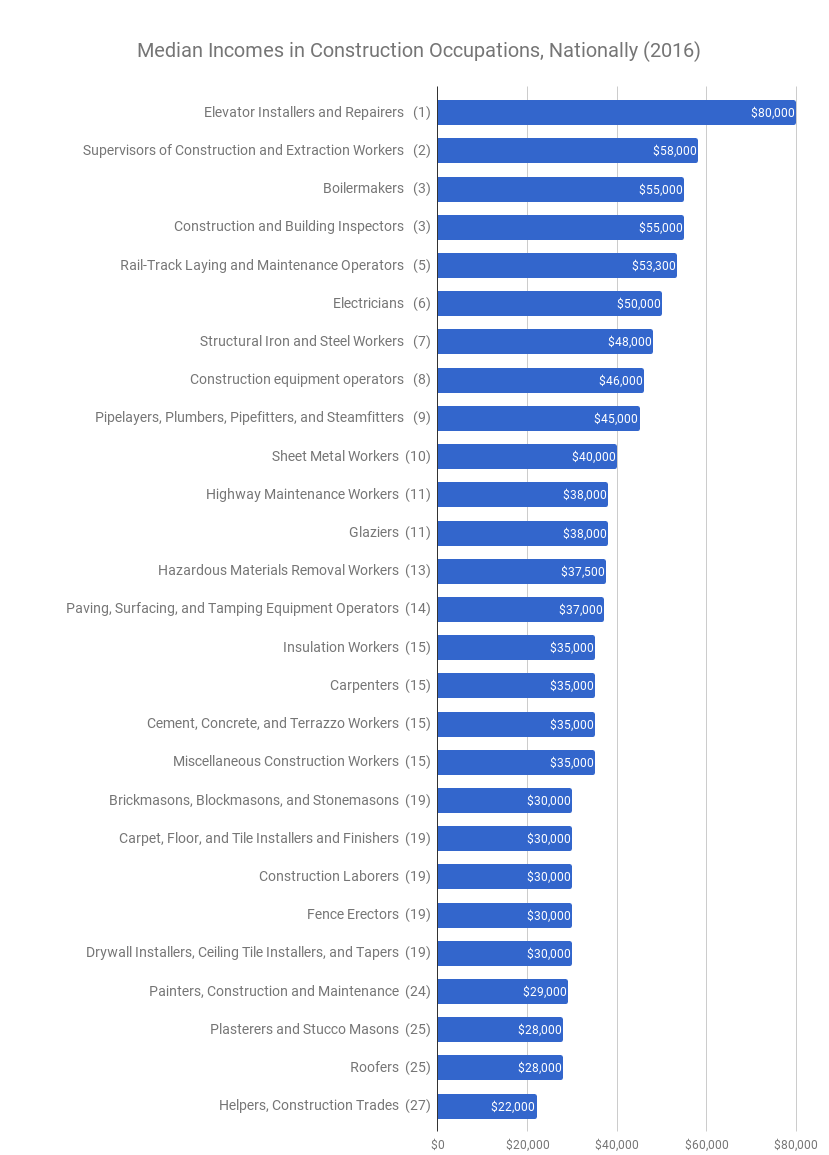The study looks at the diversity of jobs that exist in construction, and also identifies broad patterns that identify higher-paid workers as well as “certain cities that offer better pay across the board for all construction jobs,” David said.
It’s important to note that cement, concrete and terrazzo workers in this study are shown to make $35,000/year and brickmasons, block masons and stone masons as well as carpet, floor and tile installers and finishers make $30,000/year – a far cry from elevator installers and repairers at $80,000 annually, or construction and building inspectors at $55, 000.
David’s analysis indicates that higher wages are often commanded by supervisors, engineers and inspectors, but skilled “blue collar” positions also can bring in more robust salaries.
“People tend to associate white-collar or office jobs with higher salaries compared to blue-collar or manual labor, but the rankings show that this is not necessarily the case,” she said. “Working with elevators or boilers requires physical work, but these are among the highest paid jobs in the industry.”
Skilled labor = higher wages
An important factor in this wage analysis, David said, is level of skill required. “Occupations that require more training or technical expertise consistently pay higher than those with lower barriers to entry,” says BuildZoom’s Chief Economist, Dr. Issi Romem.
David added, “The highest-paying occupations often require specialized apprenticeships, licenses or certifications that demonstrate an understanding of the trade and command a premium in the market, such as a grounding in mechanics for elevator technicians, circuitry for electricians, or water systems for boilermakers. Of course, licensing can also serve as a means for controlling the number of people practicing and by reducing the supply of those tradesmen, increase their wages.
“Towards the bottom of the list are trades that generally have lower barriers to entry. Floor installers, construction laborers, drywall installers, painters and roofers are listed on the Bureau of Labor Statistics as having ‘no formal education credentials’ required, while professions with average pay including pipelayers, sheet metal workers, glaziers, insulation workers, and carpenters typically require ‘a high school diploma or equivalent.’
“There are people in our industry and outside of our trade who contest that tile installation costs are already too high,” said Bart Bettiga, NTCA Executive Director. “But I believe that the overall cost of installation will come down if we have more highly skilled people installing tile and stone. These products are not meant to be put in by an untrained workforce. Tile and stone are most often selected because they are considered to be a permanent finish. For this to be the case, we need to have a highly trained and a highly compensated workforce.”
This finding that correlates higher wages with a skilled workforce is of particular interest to NTCA, which has its core mission to educate and train installers and raise their skill level.
“For the past several years, the NTCA has been developing its online apprenticeship curriculum,” said Bart Bettiga, NTCA Executive Director. “We have worked with several of our members to help them use this educational tool to recruit new people into the trade and to train their current staff. It is our hope that this program can be integrated with supervised and field-related training.
“The reason this is so important is that we believe that tile installation is a highly skilled craft that takes several years to master,” Bettiga added. “Why is this important? Because we have a big job to do, and it is perfectly illustrated in this paper. We must raise the wages of our trained tile installers if we are going to recruit talented young people into our trade. We cannot continue to be grouped with other flooring trades that quite frankly are not as complex, nor do they take as long to master. Tile installers should be making wages like other trades that are considered to be highly skilled.”
David’s analysis also shows “ordering of occupations from highest-paid to lowest-paid at the national level,” and “within individual metro areas. Within any given city, supervisors are paid the most and painters the least, with an overall downward slope.”
Some cities are more generous with construction wages. For instance, carpet and flooring workers earn more than the national average in both the San Jose/San Francisco/Oakland region and the New York/Newark /Pennsylvania/Connecticut regions than Dallas/Fort Worth or Miami/Fort Lauderdale.




“The higher incomes in San Jose and New York suggest they may be related to how expensive it is to live in those cities,” David said. “The Cost of Living Index measures the difference in the price levels of goods, services, and rent across the US, where 100 is set as the average national cost of living. San Jose and New York have Cost of Living Indexes of 124 and 121, which are respectively the second and fifth most expensive cities in the US.”
“Wages are consistently higher across all construction occupations in certain cities, in line with the cost of living,” summarized Romem.
On the other hand, cost of living is lower in Dallas and Miami, with indices of 100 and 106 respectively, David pointed out. These lower costs of living give“people greater purchasing power than expensive cities like San Francisco or New York,” she said.
<Cities with lower wages charts – 2>




So how do construction occupations rank in your city? Use the dropdown at http://bit.ly/2osxF8B to display the rankings for your city.
The above rankings and spider charts for large cities are available for download in the links below.
- Download Occupation Rankings By Metro Area
- Download Metro Area Comparisons to National Median
See the BuildZoom story at http://bit.ly/2osxF8B for notes and methodology and downloads for Occupation Rankings by Metro Area and Metro Area Comparisons to National Median.
_______________________________________________________________________
Editorial Director and Senior Writer for TileLetter and TileLetter ARTISAN
Lesley Goddin has been writing and journaling since her first diary at age 11. Her journey has taken her through a career in publishing and publicity, landing her the editor position of TileLetter and its special publications in 2006. Her goal is to educate, inspire, recognize and encourage those in the tile industry -- especially the tile and stone contractor.










